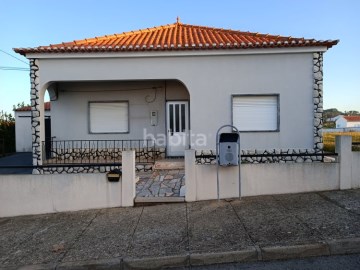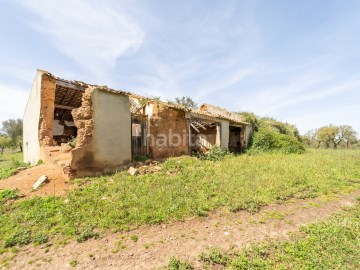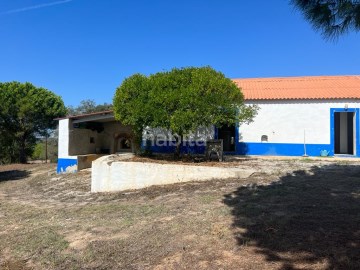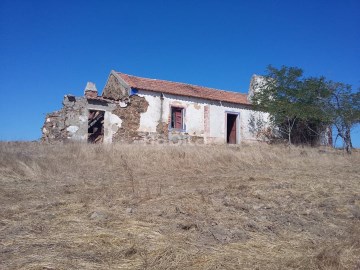House 2 Bedrooms in Abela
Abela, Santiago do Cacém, Setúbal
2 bedrooms
1 bathroom
90 m²
House located in Aldeia da Abela, 14km from the city of Santiago do Cacém, on a plot of 247.50m2, with excellent sun exposure
With a construction area of 90m2, it consists of two bedrooms, living room, kitchen, pantry, bathroom, garage and a small backyard.
Mains electricity and water.
Bank Financing:
Habita is a partner of several financial entities, enabling all its customers to have free simulations of Housing Loans.
Location:
Santiago do Cacém is a Portuguese city in the District of Setúbal, it is the seat of one of the largest municipalities in Portugal, with an area of 1,059.77 km².
It is the seat of one of the largest municipalities in Portugal, with an area of 1,059.77 km² and 29,749 inhabitants (2015 INE), subdivided into 8 parishes.
The municipality is bordered to the north by Grândola, to the northeast by Ferreira do Alentejo, to the east by Aljustrel, to the south by Ourique and Odemira and to the west by Sines and has a coastline on the Atlantic Ocean. It is the only municipality in the whole of Alentejo that contains 2 cities within its boundary (Santiago and Santo André). It also has three villages (Cercal, Alvalade and Ermidas-Sado).
History:
Its name derives from the Moorish Governor Kassim and the Order of Santiago.
Endowed with a strategic geographical location, human populations have sought this region since ancient times to settle. The excavations carried out in the Old Castle, where the Roman ruins of Miróbriga are located, show that the region has been inhabited since prehistoric times.
The ruins of Miróbriga represent one of the most striking vestiges of the Roman occupation in the Southwest of Portugal.
It was classified as a Property of Public Interest in 1940. The Roman city stretches for more than 2 km, featuring ruins of residential buildings, paved streets, a hippodrome, baths, a bridge, and a forum.
With the Roman colonisation, it developed into the commercial area around the forum. The thermal baths, among the best preserved in Portugal. Relatively close to the baths, there is a bridge with a single semicircular arch. The hippodrome is the only one completely known in Portugal and is located further away from the centre.
It was around 712 and after the decline of Miróbriga that the Moors reached the territory, building the castle on the hill in front; it is even thought that the name Kassem will be linked to the Moorish mayor. The Moorish occupation lasted until the eighteenth century. XII and many battles for the reconquest were fought in the territory until, in 1217, it definitively returned to the possession of the Christians, with D. Afonso II confirming the donation of his father to the Order of Spatharii.
Economy:
In the municipality, activities related to the primary sector predominate, followed by those of secondary and tertiary sectors.
Agriculture still remains very important, with 43.9% of the municipality's area dedicated to agricultural exploitation, with emphasis on the cultivation of cereals for grain, temporary meadows and fodder crops, industrial crops, fallow, olive groves, meadows and permanent pastures.
Livestock farming is also of some importance, particularly in the rearing of poultry, sheep and pigs.
About 7785 hectares of its territory are covered with forest.
Thus, agriculture, pig farming and rice husking are the most important activities, followed by industry, namely auto workshops, civil construction, civil locksmithing, marble processing, wood sawmilling and cork processing.
Culture and leisure:
There are many popular and cultural events in the municipality: the feast of Our Lady of Grace, held on the last Sunday of May, with various religious ceremonies, namely prayer meetings, and the annual fairs, on the fourth Sunday of April and the fourth Sunday of July; Santiagro, 'Agricultural Fair', in May, for economic and cultural promotion; FATAL - Handicraft and Tourism Fair of the Alentejo Litoral; the traditional festivals of Relvas Verdes, both in July; the Monte Fair, in September; the traditional festivities of Aldeia dos Chãos, in August, and the Day of the Municipality, on July 25th.
In handicrafts, tinsmithing, lace, embroidery, clay and cork work, tapestry and wood stand out.
As a cultural facility, the municipality has the Municipal Museum of Santiago do Cacém, in which the numismatics and archaeology sections are noteworthy, the latter representative of the human occupation in the region, since the times of the Upper Palaeolithic. In the ethnography collection, the highlight is the traditional Alentejo cuisine, to which is added the recreation of a popular room, which contrasts with another with a markedly bourgeois taste and which is part of a remarkable legacy of one of the families of the region - the Counts of Avillez.
In 1895, the first automobile arrived in Portugal, owned by the Count of Avilez, from Santiago do Cacém;
As a curiosity, the 1st Rolls Royce that came to Portugal, also came to Santiago do Cacém, owned by José Sande Champalimaud and the car registration with no. 1, in 1904, also went to Santiago do Cacém, in the name of Augusto Teixeira de Aragão.
Points to visit:
- Castle of Santiago do Cacém
- Miróbriga Archaeological Station
- Municipal Museum of Santiago do Cacém
- Castle of Santiago do Cacém
- Badoca Safari Park
- Medieval bridge of Alvalade
- Old Castle area with the ruins of the Roman city Miróbriga
- Church of Santiago or Mother Church of Santiago do Cacém
#ref:IS122302
200.000 €
30+ days ago supercasa.pt
View property



